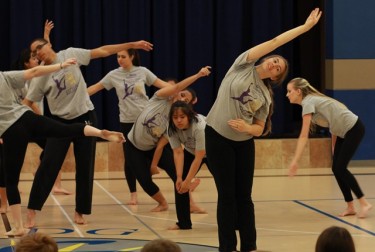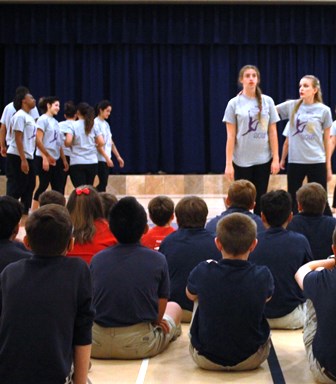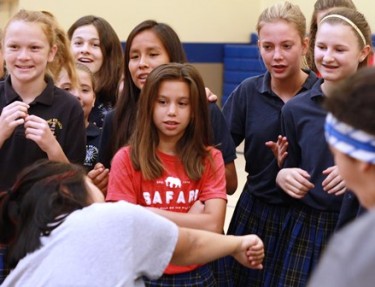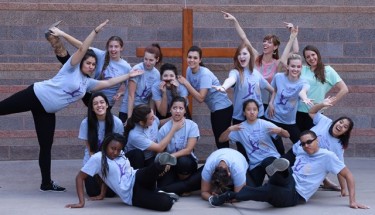Story by Janie Magruder
Photos by Tyler McDonald
GCU News Bureau
Every time Khaila Matthews stepped onto a gym floor in a local school this spring to perform with other Grand Canyon University dance students, the emotional seesaw of her own adolescence teetered in her memory. The GCU sophomore wondered whether she and the dozens of sixth-graders seated cross-legged in front of her had more in common than they might imagine.
“I was bullied at their age,” Matthews said recently after the final performance of the College of Fine Arts and Production’s Elementary and Middle School Dance Tour. “I had darker skin, a fuller figure, I was really different. Now, being able to go to these schools and show these kids that there’s nothing wrong with being different, it makes me feel really good.”
The GCU sophomore was among 16 students who spent the fall and spring semesters conceptualizing, writing and choreographing the Dance Department’s fourth annual tour. Through the school visits, COFAP aims to spark young audience members’ impulse for self-expression by offering creative tools that will help them explore drama, music and, in this case, drama.
The culmination of the dance students’ efforts was being able to perform for free at five schools, including St. Francis Xavier Elementary in Phoenix. Led by Susannah Keita, the Dance Department’s director, and faculty member Leanne Schmidt, the students wowed an estimated 1,000 preteens and young teenagers at the schools with their show, “Me + You = We.”
It was an equation the Xavier students were attentive to from the first note of music and had solved well before the 25-minute performance ended.
Teacher Anne Sanford said the piece generated plenty of discussion later in class about a range of topics, from the use of dance as a storytelling device to the importance of inclusion, especially at their age.
“We talked about opening our circles, which is a phrase we use quite a bit when we think about kids physically sitting in a circle and having a closed circle and not letting people in,” Sanford said. “That’s a problem sixth graders have. They are figuring out their friendship groups and where they ‘belong.’ We talked about being cognizant about people just being themselves and not being included because of that.”
The genesis of a powerful, student-led performance
Last fall, Schmidt and the dance students started the process by talking about the trials and tribulations of being in middle school. “We said, ‘Let’s make a piece about the cruelties of that age and how people can be left out,” said GCU sophomore Tamrae Wright, a dance education major.
The students revealed the insecurities and hurt feelings they’d experienced in their youth. “We asked, ‘What is something you dealt with in middle school?’ and everybody had something, but for the majority it was peer pressure,” Wright said.
The group then worked for weeks on the story line, writing the narrative and adding movement that included ballet, hip hop, modern, improvisation, jazz and other genres. The piece was finessed and evolved during hours of rehearsals before the tour began in February.
Even though some of the GCU students have had dance training for 20 years, the creative process was new for many, including senior dance education major Alexe Biggs, who transferred to the program last fall.
“The entire piece was collaborative, and it was good to know there’s another way to do it — we don’t just have to come up with movement by ourselves,” Biggs said.
Wright said the dancers had to step outside their comfort zones to improvise. However, “once we got accustomed to the process, it became really fun,” she said.
At Xavier, Biggs asked the students to raise their hands if they were different, for example, by having green eyes or siblings. Were they set apart from the others by wearing black socks or blue shoes? People form associations by their clothing, backgrounds and personalities, but sometimes they become unhealthy and cliquish, Wright told the students.
As the dance began, she portrayed the girl who is left out, shunned or mocked by other people who try to change her to be like them. Wright was the quirky wallflower who doesn’t fit in with the popular kids, and she decides to become like them. But as the piece progressed, she wondered, “Is fitting in really worth it?”
Another dancer declared to the group, “I’m a leader, you follow me, you do what I say when I say it.”
But Wright eventually stayed true to her herself, and the other dancers became more accepting, telling the sixth graders: “She has her own dreams,” “He has his own choices,” and “We are all special and unique.”
The piece closed with an emotional scene led by Biggs, who gently guided each dancer to a place on the floor where their bodies built a bridge for Wright to walk cross. “You fit here,” “We need your help here,” and “You and me is we,” Biggs said.
Wright’s acceptance by her peers is complete, and they all dance together.
“This piece is meant for you to talk to each other and talk to your teachers about things that you see that might be hurtful,” Schmidt told the group at the end.
The tour’s impact on arts education and GCU students
Just 3 percent of elementary schools include dance in their curriculum, according to the 2009-10 Arizona Arts Census.
“Very few schools in Arizona and across the country offer dance or theatre for elementary grades even though most people share an implicit understanding that young people learn best through kinesthetic, visual and hands-on strategies,” Keita said. “The tour provides a singular experience to students, one that can leave a lasting impression.”
Xavier students don’t have dance class, Sanford said. Girls do have a dance unit in physical education class, but boys don't.
“Dance and music was such an effective way to communication this idea,” she said. “And we know that kinetic energy builds brainpower and gets kids physically moving.”
After the performance, the sixth graders surrounded the GCU dancers to ask them questions about their favorite genres of dance and to demonstrate some of their own moves.
Wright said she loved the tour because of that interaction. “As a student, this has shown me how GCU’s dance program can have an impact on the community around us, and it has given me insight into things I can apply to my dance career,” she said.
Biggs agreed, saying she already can see how she might incorporate parts of the tour into her own classroom someday.
Matthews was among the GCU students who said they won’t soon forget a young girl’s reaction to one of the performances earlier in the semester. When she came up to the dancers, she was weeping and saying how beautiful the piece was. “I was amazed at the power that arts can play in a kid’s life,” Wright said.
Biggs said she was surprised by the variety of reactions at each performance.
“Even the younger students — we had some kindergartners at one show — have been able to articulate what they’ve taken away from the piece,” she said.
A Q-and-A session, hosted by the GCU dancers, revealed that the students got the message.
“Be yourself!” one girl responded.
“Don’t change to fit in,” a boy said.
“It takes a friend to build you back up when you’ve been torn down.”
“Look to find people who accept you for you are.”
“You have to know in your heart to not judge people, but to love them.”
Keita and Schmidt already are looking ahead to next year’s program. They plan to visit the dance classroom of Alyssa Ernst, a 2014 graduate of the GCU Dance Education program who teaches at Herrera Elementary in Phoenix, among others.
“We usually invite the participating elementary students to participate in movement games and mini-choreography projects, making it about half-performance and half-interactive lesson,” Keita said. “As a result, kids get that experience and our teacher candidates have a chance to lead youth in small groups. We’ll do that again in the future.”
Contact Janie Magruder at 602-639-8018 or [email protected].









